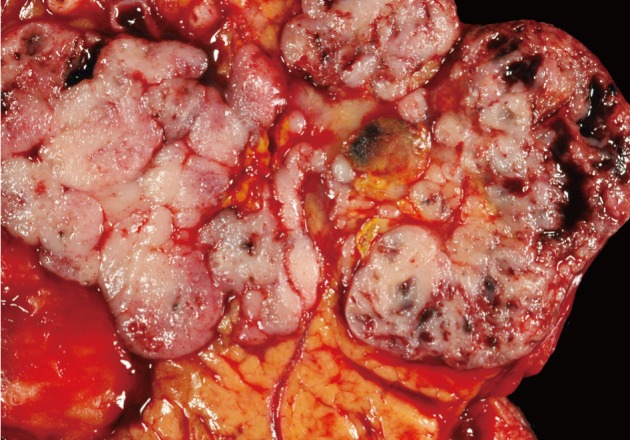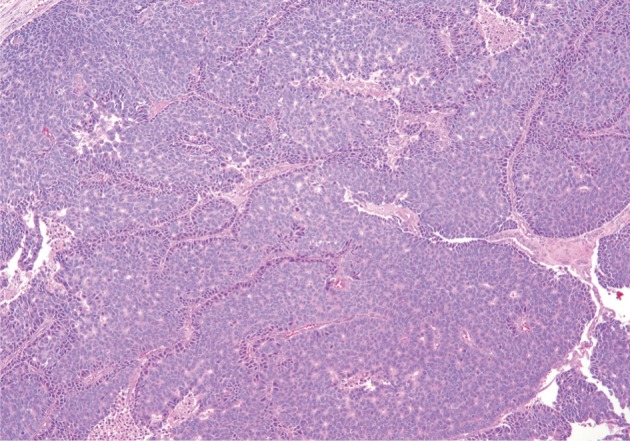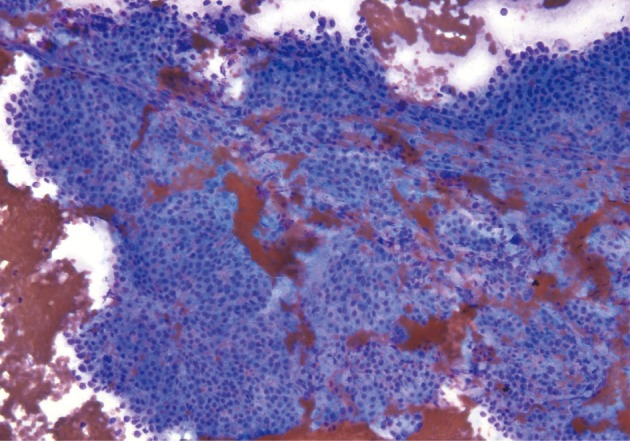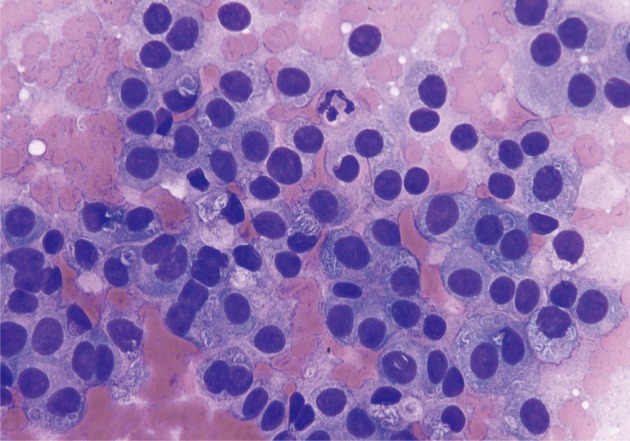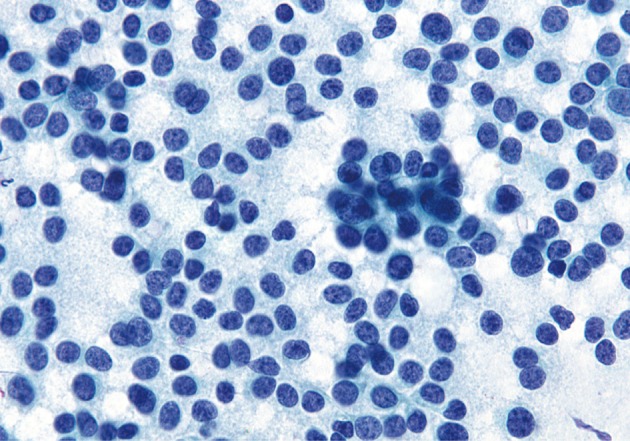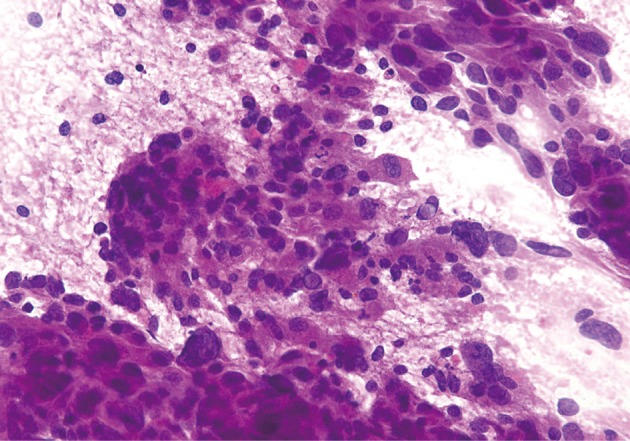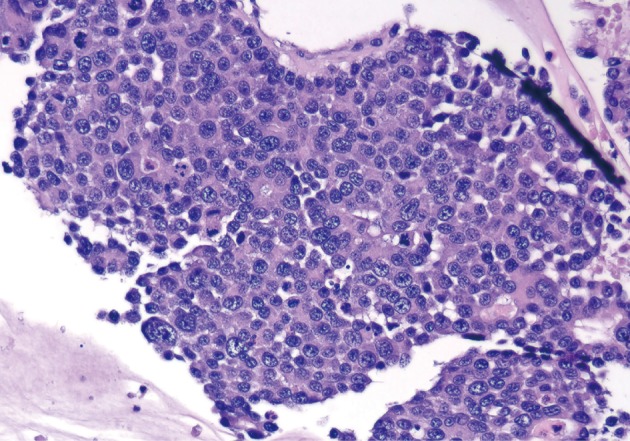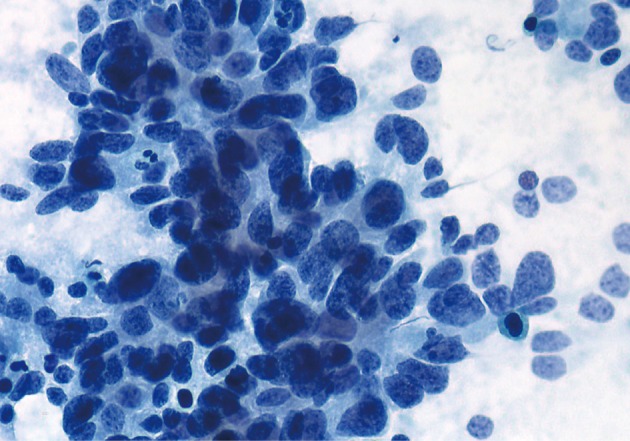Articles
- Page Path
- HOME > J Pathol Transl Med > Volume 47(2); 2013 > Article
-
Review & Perspective
Acinar Cell Carcinoma of the Pancreas: Clinical and Cytomorphologic Characteristics - Adam D. Toll1, Ralph H. Hruban1,2, Syed Z. Ali1,3
-
Korean Journal of Pathology 2013;47(2):93-99.
DOI: https://doi.org/10.4132/KoreanJPathol.2013.47.2.93
Published online: April 24, 2013
1Department of Pathology, The Johns Hopkins Hospital, Baltimore, MD, USA.
2The Sol Goldman Pancreatic Cancer Research Center, The Johns Hopkins Hospital, Baltimore, MD, USA.
3Department of Radiology, The Johns Hopkins Hospital, Baltimore, MD, USA.
- Corresponding Author: Syed Z. Ali, M.D. Department of Pathology, The Johns Hopkins Hospital, Path 406, 600 N. Wolfe St. Baltimore, MD 21287, USA. Tel: +1-410-955-1180, Fax: +1-410-614-9556, sali@jhmi.edu
• Received: February 7, 2013 • Revised: February 28, 2013 • Accepted: March 5, 2013
© 2013 The Korean Society of Pathologists/The Korean Society for Cytopathology
This is an Open Access article distributed under the terms of the Creative Commons Attribution Non-Commercial License (http://creativecommons.org/licenses/by-nc/3.0/) which permits unrestricted non-commercial use, distribution, and reproduction in any medium, provided the original work is properly cited.
Figure & Data
References
Citations
Citations to this article as recorded by 

- Survival Outcomes and Genetic Characteristics of Resected Pancreatic Acinar Cell Carcinoma
Alex B. Blair, Shannon N. Radomski, Joanne Chou, Mengyuan Liu, Thomas Clark Howell, Wungki Park, Eileen M. O’Reilly, Lei Zheng, Vinod P. Balachandran, Alice C. Wei, T. Peter Kingham, Michael I. D’Angelica, Jeffrey Drebin, Sabino Zani, Dan G. Blazer, Richa
Annals of Surgical Oncology.2025; 32(3): 1869. CrossRef - Pancreatic acinar cell carcinoma: a rare entity
Sara C. CASTANHEIRA RODRIGUES, Sofia VERÍSSIMO PEDROSA, Carolina COUTINHO, Miguel MACHADO, Marisa ARAL, Humberto CRISTINO, Jorge PINHEIRO, Luís GRAÇA, Elisabete BARBOSA
Chirurgia.2025;[Epub] CrossRef - Pancreatic panniculitis associated with presumed advanced pancreatic tumor: A case report and literature review
Dunya Yang, Shouyue Chen, Xiaoyu Zhang, Xiangwu Lin, Shaoqin Lin, Qunxiang Chen, Zongjing Zhang, Jie Li, Xi Chen
Pathology - Research and Practice.2025; 275: 156214. CrossRef - Comprehensive review of pancreatic acinar cell carcinoma: epidemiology, diagnosis, molecular features and treatment
Kenji Ikezawa, Makiko Urabe, Yugo Kai, Ryoji Takada, Hirofumi Akita, Shigenori Nagata, Kazuyoshi Ohkawa
Japanese Journal of Clinical Oncology.2024; 54(3): 271. CrossRef - Liquid-based cytology features of pancreatic acinar cell carcinoma: comparison with other non-ductal neoplasms of the pancreas
Minji Kwon, Seung-Mo Hong, Kyoungbun Lee, Haeryoung Kim
Journal of Pathology and Translational Medicine.2024; 58(4): 182. CrossRef - A narrative review on rare types of pancreatic cancer: should they be treated as pancreatic ductal adenocarcinomas?
Victor Hugo Fonseca de Jesus, Mauro Daniel Spina Donadio, Ângelo Borsarelli Carvalho de Brito, Arthur Conelian Gentilli
Therapeutic Advances in Medical Oncology.2024;[Epub] CrossRef - Misunderstood Gastric Perforation of a Pancreatic Acinar Cell Carcinoma: A Wolf in Sheep’s Clothing
Manuela Cuoghi, Cinzia Baccaro, Noemi Zorzetti, Adele Fornelli, Francesco Ferrara, Vincenzo Cennamo, Giuseppe Giovanni Navarra
Surgeries.2023; 4(1): 73. CrossRef - A case of unresectable ectopic acinar cell carcinoma developed in the portal vein in complete response to FOLFIRINOX therapy
Shinnosuke Nakayama, Akihisa Fukuda, Tadayuki Kou, Manabu Muto, Hiroshi Seno
Clinical Journal of Gastroenterology.2023; 16(4): 610. CrossRef - Rare Solid Pancreatic Lesions on Cross-Sectional Imaging
Ana Veron Sanchez, Nuria Santamaria Guinea, Silvia Cayon Somacarrera, Ilias Bennouna, Martina Pezzullo, Maria Bali
Diagnostics.2023; 13(16): 2719. CrossRef - Pancreatic acinar cell carcinoma: A comprehensive review
Luis Fernando Calimano-Ramirez, Taher Daoud, Dheeraj Reddy Gopireddy, Ajaykumar C Morani, Rebecca Waters, Kazim Gumus, Albert Russell Klekers, Priya R Bhosale, Mayur K Virarkar
World Journal of Gastroenterology.2022; 28(40): 5827. CrossRef - Germline BRCA2 variants in advanced pancreatic acinar cell carcinoma: A case report and review of literature
Cha Len Lee, Spring Holter, Ayelet Borgida, Anna Dodd, Stephanie Ramotar, Robert Grant, Kristy Wasson, Elena Elimova, Raymond W Jang, Malcolm Moore, Tae Kyoung Kim, Korosh Khalili, Carol-Anne Moulton, Steven Gallinger, Grainne M O’Kane, Jennifer J Knox
World Journal of Gastroenterology.2022; 28(45): 6420. CrossRef - Germline BRCA2 variants in advanced pancreatic acinar cell carcinoma: A case report and review of literature
Cha Len Lee, Spring Holter, Ayelet Borgida, Anna Dodd, Stephanie Ramotar, Robert Grant, Kristy Wasson, Elena Elimova, Raymond W Jang, Malcolm Moore, Tae Kyoung Kim, Korosh Khalili, Carol-Anne Moulton, Steven Gallinger, Grainne M O’Kane, Jennifer J Knox
World Journal of Gastroenterology.2022; 28(45): 6421. CrossRef - Pancreatic Acinar Cell Carcinoma with Germline BRCA2 Mutation and Severe Pancreatic Panniculitis: A Case Report
Lena Dreikhausen, Nadine Schulte, Sebastian Belle, Philip Weidner, Johannes Moersdorf, Christoph Reissfelder, Matthias P. Ebert, Tianzuo Zhan
Visceral Medicine.2021; 37(5): 447. CrossRef - The Unusual Suspects of the Pancreas—Understanding Pancreatic Acinar Cell Carcinomas and Adenomas
Andreas Minh Luu, Tim Fahlbusch, Johanna Munding, Waldemar Uhl, Chris Braumann
Journal of Gastrointestinal Cancer.2020; 51(1): 172. CrossRef - The contemporary trend in worsening prognosis of pancreatic acinar cell carcinoma: A population-based study
Nie Duorui, Bin Shi, Tao Zhang, Chuyao Chen, Chongkai Fang, Zhijun Yue, Peng Wu, Zhiming Wu, Xuewu Huang, Meng Li, Girijesh Kumar Patel
PLOS ONE.2020; 15(12): e0243164. CrossRef - Metastatic pancreatic acinar cell carcinoma in a younger male with marked AFP production: A potential pitfall on fine needle aspiration biopsy
Kari Valente, George Yacoub, James O. Cappellari, Graham Parks
Diagnostic Cytopathology.2017; 45(2): 133. CrossRef - Establishment and characterization of a new human acinar cell carcinoma cell line, Faraz-ICR, from pancreas
Marzieh Rezaei, Ahmad Hosseini, Saman Nikeghbalian, Abbas Ghaderi
Pancreatology.2017; 17(2): 303. CrossRef - Multimodal approach and long-term survival in a patient with recurrent metastatic acinar cell carcinoma of the pancreas: A case report
Sarah F. Jauch, Van K. Morris, Corey T. Jensen, Ahmed O. Kaseb
Pancreatology.2016; 16(1): 153. CrossRef - Cytopathologic diagnosis of oncocytic type intraductal papillary mucinous neoplasm: Criteria and clinical implications of accurate diagnosis
Michelle D. Reid, Christina R. Stallworth, Melinda M. Lewis, Gizem Akkas, Bahar Memis, Olca Basturk, Volkan Adsay
Cancer Cytopathology.2016; 124(2): 122. CrossRef - Skin Metastases: The Visible Face of a Disastrous Unusual Finding
Sílvia Giestas, Adriano Casela, Cláudia Agostinho, Paulo Souto, Ernestina Camacho, M. Julião, Maria Augusta Cipriano, Carlos Sofia
GE Portuguese Journal of Gastroenterology.2016; 23(5): 282. CrossRef - Acinar Cell Carcinoma of the Pancreas: A Literature Review and Update
Poras Chaudhary
Indian Journal of Surgery.2015; 77(3): 226. CrossRef - Acinar Cell Carcinoma of the Pancreas
Stephanie Simmons, Isam A. Eltoum
Pathology Case Reviews.2015; 20(4): 192. CrossRef - Brush cytology of acinar cell carcinoma of the pancreas with intraductal growth
Yasuhiro Toyonaga, Kazuto Yamazaki, Masatoshi Yamada, Takayoshi Koyasu, Yoshinori Koyama, Yasuo Ishida
Diagnostic Cytopathology.2014; 42(4): 321. CrossRef - DNA Mismatch Repair Abnormalities in Acinar Cell Carcinoma of the Pancreas
Weiguo Liu, Jinru Shia, Mithat Gönen, Maeve A. Lowery, Eileen M. O’Reilly, David S. Klimstra
Pancreas.2014; 43(8): 1264. CrossRef - Tumeurs acinaires du pancréas : particularités pronostiques. A propos de 4 cas
Z. Mzoughi, N. Azzabou, N. Miloudi, L. Gharbi, M. T. Khalfallah
Journal Africain d'Hépato-Gastroentérologie.2014; 8(3): 113. CrossRef
 PubReader
PubReader ePub Link
ePub Link-
 Cite this Article
Cite this Article
- Cite this Article
-
- Close
- Download Citation
- Close
- Figure
Acinar Cell Carcinoma of the Pancreas: Clinical and Cytomorphologic Characteristics








Fig. 1 Acinar cell carcinoma (ACC). ACCs are typically large (10 cm), fairly well-circumscribed, soft and fleshy. Less commonly, they can be fibrotic or form cystic masses. Other pancreatic neoplasms that form fleshy masses include well-differentiated pancreatic neuroendocrine tumor, pancreatoblastoma, solid-pseudopapillary neoplasm, and lymphoma.
Fig. 2 Acinar cell carcinoma. Neoplastic cells show acinar formations, relative cellular monotony, and foci of necrosis. Thin bands of fibrosis separate islands of neoplastic cells.
Fig. 3 Acinar cell carcinoma. Poorly differentiated neoplastic cells with focal acinar formations, large nuclei exhibiting irregular chromatin clumping, size variation, and varying N/C ratios. Many mitotic figures are present, consistent with aggressive growth.
Fig. 4 Acinar cell carcinoma. Partially intact tissue fragment with neoplastic cells has moderately hyperchromatic, uniform nuclei and delicate basophilic cytoplasm. A lack of single dispersed cells may help to differentiate this from a pancreatic neuroendocrine tumor (Diff-Quik stain).
Fig. 5 Acinar cell carcinoma. Single cells with round to ovoid, centrally- or eccentrically-located nuclei. Some of the neoplastic cells contain entangled cord-like clear areas of unknown significance. A well-differentiated endocrine neoplasm is often a difficult diagnosis to exclude, and all such cases should be immunolabeled before a definitive diagnosis is made (Diff-Quik stain).
Fig. 6 Acinar cell carcinoma. Neoplastic cells arranged singly or in groups. There are round to ovoid nuclei with uniform chromatin patterns and delicate, fragile cytoplasm. While these features are typical of acinar cell carcinomas, they may also be present in some well-differentiated pancreatic neuroendocrine tumors (Papanicolaou stain).
Fig. 7 Acinar cell carcinoma (ACC). Poorly differentiated ACC. Neoplastic cells are disorganized, but several atypical acinar formations are present. The acinar formations can be easily confused with "rosettes" of an endocrine neoplasm (Papanicolaou stain).
Fig. 8 Acinar cell carcinoma. Poorly differentiated neoplastic cells with bizarre, pleomorphic nuclei, macronucleoli, and eosinophilic cytoplasm are observed. Several well-formed intranuclear pseudoinclusions are present. The smear background is characteristically granular.
Fig. 1
Fig. 2
Fig. 3
Fig. 4
Fig. 5
Fig. 6
Fig. 7
Fig. 8
Acinar Cell Carcinoma of the Pancreas: Clinical and Cytomorphologic Characteristics

 E-submission
E-submission
